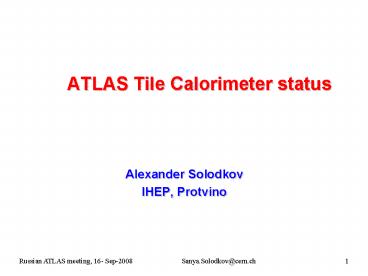ATLAS Tile Calorimeter status - PowerPoint PPT Presentation
1 / 15
Title:
ATLAS Tile Calorimeter status
Description:
20 cells have one masked channel (information can be recovered using the ... a structure related to the the toroid magnets structure and an up-down asymmetry. ... – PowerPoint PPT presentation
Number of Views:162
Avg rating:3.0/5.0
Title: ATLAS Tile Calorimeter status
1
ATLAS Tile Calorimeter status
- Alexander Solodkov
- IHEP, Protvino
2
TILE HARDWARE STATUS
- From M8
- Over about 5k cells, 10k channels
- 43 masked cells (two drawers)
- 20 cells have one masked channel (information can
be recovered using the other channel) - Status on 12-Sep
- Three drawers do not send data
- One drawer is unstable (need to cycle power from
time to time) - Two drawers send some of corrupted events
- Total number of affected cells is 100 - 2 (but
not in all events) - We are within the 5 of failures needed for
expected Missing ET reconstruction performances.
Each module corresponds to 0.1 in phi.
3
MASKED LONG BARREL DRAWER
Picture of TTC fiber in USA15
Cladding
Dust
Low TTC light level dust covering the TTC
fiber.
Two kind of recoverable problems in
TileCal Optical link problems (dust, bad optical
connectors etc) - fibers are accessible for
cleaning from USA15 side Low voltage in the
drawers outside specifications fine tuning is
possible
Now problems enormously reduced
4
TILE WITH THE MAGNETIC FIELD ON
- No problems with front-end electronics and power
supplies during current ramp-up and at full
magnetic field. - PMTs gains appear to be stable (needs more
confirmation using Laser calibration)
Observe an 1.5 increase in the tiles light
response when solenoid field is on.
Ratio of cell response with/without solenoid on
More study is needed but will need to apply extra
calibrations in cells with field on
Eta of outermost Cells
5
TILECAL CALIBRATION
DSP/ROD
PMT
Electronics
Tile Cell
Charge Injection (CIS) (taken daily/weekly)
Laser (taken daily/weekly)
Cesium Source (taken when no beam for gt 8hours)
ADC to MeV conversion factors (together with
testbeam)
Online energy calculation
Optic checks and Cell response equalization
Timing and PMT gain stability
Also pedestal runs to monitor the detector and to
extract noise values
For monitoring stability, plan to take Laser and
CIS events (fixed intensities and charges) in
the long bunch gaps during beam running
6
TILECAL CALIBRATION CONSTANTS
Cesium Calibration Constants (relative
equalization) All cells are equalized, constants
for 20 cells deviate by more than 5 from mean,
all constants will go to database this week CIS
constants (ADC -gt pCb factor) constants are in
the database. Factor to bring response to EM
scale (pCb -gt MeV factor) Different constants
for samplings A, BC and D in the database
(measured at the testbeam) Timing Constants for
Laser events all values are in the
database. Timing Constants for Physics events
will be measured in collisions, nothing in
database yet Pedestals and Noise real values
begin to be in the database. Optimal Filter
Coefficient for online energy calculation real
constants are in the database.
7
TILECAL RECONSTRUCTION
For single beam and first collisions will run the
same reconstruction algorithms as for
cosmics All ADC samples will be sent from
RODs Optimal filter will run offline, energy and
time (position of max) will be fitted, results
will be compared with reconstruction done inside
RODs Once enough statistics is accumulated for
all cells, will switch to optimal filter without
iterations (fixed position of maximum)
8
DATA QUALITY STATUS (1)
It has been exercised a lot in calibration and
cosmic data. Several diagnostics plots available
to spot problems and to go into details. DQ
shifts for calibration runs started two years ago
DQMF tools well debugged.
Data corruption plot Pedestal level plot
9
DATA QUALITY STATUS (2)
- Tier0 monitoring used routinely by TileCal DQ
shifter. - 2D Occupancy maps available (partition vs
module module vs channel
eta vs phi) hot/dead channels can be identified
very quickly by shifters. - Plots for single cell quantities available
- Reference plots reviewed
CH
MODULE
10
DATA QUALITY STATUS (3)
Tower and Cluster are already at Tier0, done only
with TileCal cells. Development ongoing
with LAr and L1Calo on a combined package
(CaloMonitoring) to provide histograms from
clusters done with cells of all calorimeters
(http//atlaswww.hep.anl.gov/asc/TileCal/offlineDQ
M ).
Position most energetic tower
Tile All Cluster Energy
Eta Position of most energ. Cluster
Mean cell energy
FDR2 data
Energy fraction from TileCal cell
Tower
11
CONCLUSIONS
- Very few unusable-for-physics regions in Tile.
- Most of calibration constants are in the
databases. - Advanced tools in place for data quality
assessment - Turning to focus on combined calorimeter
qualities in addition to hardware-based qualities - Now we are ready for the beam
12
Appendix first splash events in TileCal
13
Energy study
- In the splash events from beam2 of Wednesday
evening, run 87851 BPTX trigger, we observe 26
events with more than 1000 TeV in TileCal. Many
more have been collected in runs of the same day. - From a back on the envelop calculation, we
calculated the number of muons crossing TileCal.
In splash events there are more than 50.000
muons crossing TileCal detector 50.000 muons
per 1000 TeV. - We also observe a structure related to the the
toroid magnets structure and an up-down asymmetry.
13
14
Energy vs module
Legend EBCblue LBCblack LBARed EBAgreen
Finally there is an indication of the presence of
a minoritary population of hadronic particles, as
the energy observed in EBC/LBC is sensibly higher
than other partitions (beam2 comes from C-side).
Please note that TileCells are Cs
inter-calibrated at the 1 level.
We also observe an up-down asymmetry that we can
confirm is also seen in LAr.
15
Energy vs module
Tile Response
X-Y Radiography
Magnetic field
15
We compare the same energy plot in Radiography
mode with the magnetic field. The modules
response is high where the field is more intense.































